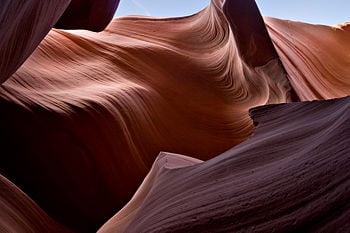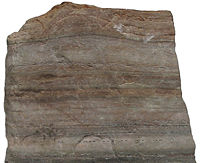Rock (geology)
A rock is a naturally occurring aggregate of minerals and/or mineraloids. Rocks are classified by mineral and chemical composition, the texture of the constituent particles, and the processes that formed them. Based on these indicators, rocks are classified as igneous, sedimentary and metamorphic. They may also be classified according to grain size.
- The study of rocks is called petrology.
The Earth's crust (including the lithosphere) and mantle are formed of rock. The crust averages about 35 kilometers (km) in thickness under the continents, but it averages only some 7-10 km beneath the oceans. The continental crust is composed primarily of sedimentary rocks resting on crystalline "basement" formed of a great variety of metamorphic and igneous rocks, including granulite and granite. Oceanic crust is composed primarily of basalt and gabbro. Both continental and oceanic crust rest on peridotite of the Earth's mantle.
Igneous rocks
Igneous rocks are formed when molten rock (magma) cools and solidifies, with or without crystallization. The word "igneous" is derived from the Latin ignis, meaning "fire." Over 700 types of igneous rocks have been described, most of which formed beneath the Earth's surface.
Igneous rocks are divided into two main categories: plutonic and volcanic rocks. Plutonic (or intrusive) rocks are produced when magma cools and crystallizes slowly within the Earth's crust. Volcanic (or extrusive) rocks are formed from magma reaching the surface either as lava or fragmental ejecta. (When the molten rock is in the mantle, it is called magma, when it is above the crust, it is called lava.) Intrusive igneous rocks usually take a few thousand years to cool, whereas extrusive igneous rocks take only a few days or weeks to cool and solidify.
- This magma can be derived from partial melts of pre-existing rocks in either the Earth's mantle or crust. Typically, the melting is caused by one or more of the following processes — an increase in temperature, a decrease in pressure, or a change in composition.
Sedimentary rocks
Sedimentary rocks cover 75% of the Earth's surface and include common types such as chalk, limestone, sandstone, clay, and shale. They are formed at or near the Earth's surface in three main ways: (a) deposition of the weathered remains of other rocks (known as "clastic" sedimentary rocks); (b) deposition of the results of biogenic activity; and (c) precipitation from solution. These processes are followed by compaction of the particulate matter and cementation.
The sedimentary rock cover of the continents of the Earth's crust is extensive, but the total contribution of sedimentary rocks is estimated to be only five percent of the total. As such, the sedimentary sequences we see represent only a thin veneer over a crust consisting mainly of igneous and metamorphic rocks.
Formation
The formation of sedimentary rock begins with the deposition of particles carried by water, wind, and glaciers to form a sediment. As the sediment builds up, pressure from the overburden ("lithostatic" pressure) squeezes the sediment into layered solids, and the liquids in the pores are expelled. This process is called "lithification" (rock formation). The term "diagenesis" is used to describe all the chemical, physical, and biological changes (including cementation) that a sediment undergoes after initial deposition and during and after lithification, excluding surface weathering.
Given their manner of formation, sedimentary rocks contain important information about the Earth's history. In particular, they contain fossils, the preserved remains of ancient plants and animals. Unlike most igneous and metamorphic rocks, they form at temperatures and pressures that do not destroy fossil remnants. The composition of sediments provides clues about the original rock. Differences between successive layers indicate changes to the environment that occurred over time.
Three types of sedimentary rocks
Clastic sedimentary rocks
Clastic sedimentary rocks are composed of discrete fragments or "clasts" of materials derived from other rocks. They are composed largely of quartz, with other common minerals including feldspars, amphiboles, and clay minerals. Sometimes there are more exotic igneous and metamorphic minerals.
Clastic sedimentary rocks may be considered according to their grain size. Shale consists of the finest particles, smaller than 0.004 mm; siltstone has slightly bigger particles, between 0.004 to 0.06 mm; sandstone is coarser still, with grain sizes of 0.06 to 2 mm; and conglomerates and breccias are the coarsest, with grains between 2 and 256 mm. Arenite is a general term for sedimentary rock with sand-sized particles.
All rocks disintegrate slowly as a result of mechanical and chemical weathering. Mechanical weathering is the breakdown of rock into particles without producing changes in the chemical composition of the minerals in the rock. Ice is the most important agent of mechanical weathering. When water percolates into cracks in the rock and freezes, it expands. The force of expansion widens the cracks and breaks off pieces of rock. Heating and cooling of the rock, and its resulting expansion and contraction, also aids the process.
Chemical weathering is the breakdown of rock by chemical reaction. In this process, the minerals in the rock are changed into particles that can be easily carried away. Air and water are both involved in many complex chemical reactions.
Biogenic (or biologic) sedimentary rocks
Biogenic sedimentary rocks contain materials generated by living organisms. They include carbonate minerals such as corals, molluscs, and foraminifera, which cover the ocean floor with layers of calcite that later forms limestone. Other examples include stromatolites, the flint nodules found in chalk (which is itself a biogenic sedimentary rock, a form of limestone), and coal (derived from the remains of tropical plants subjected to pressure).
Precipitate sedimentary rocks
Precipitate sedimentary rocks form when mineral solutions, such as seawater, evaporate. Examples include the minerals halite and gypsum.
Natural functions and human uses
The shape of the particles in sedimentary rocks has an important effect on the ability of microorganisms to colonize them. This interaction is studied in the science of geomicrobiology.
It is thought that the relatively low levels of carbon dioxide in the Earth's atmosphere (compared to that on Venus) is due to large amounts of carbon being trapped in limestone and dolomite sedimentary layers. The transfer of carbon from eroded sediments to marine deposits is part of the carbon cycle.
Sedimentary rocks are economically important in that they can be used as construction material. In addition, they often form porous and permeable reservoirs in sedimentary basins, in which petroleum and other hydrocarbons can be found.
Metamorphic rocks
Metamorphic rock is the result of transformation of a pre-existing rock type, the protolith, in a process called metamorphism. The word metamorphism means "change in form," derived from the Greek prefix meta, "after," and noun morphe, "form." The protolith may be sedimentary rock, igneous rock, or an older metamorphic rock.
Metamorphic rocks make up a large part of the Earth's crust. They are classified by texture and by chemical and mineral assembly. Some examples of metamorphic rocks are slate, gneiss, and schist. Minerals formed by the process of metamorphism include kyanite, staurolite, sillimanite, andalusite, and some garnets. Other minerals—such as olivines, pyroxenes, amphiboles, micas, feldspars, and quartz—may be found in metamorphic rocks but are not necessarily the result of the process of metamorphism. They were formed during the crystallization of igneous rocks.
Formation
Metamorphic rocks are formed deep beneath the Earth's surface, when the protolith is subjected to heat (greater than 150°C) and extreme pressures and stresses from the rocks above. These conditions lead to profound physical and chemical changes in the protolith. Metamorphic rocks are also formed by the intrusion of molten rock (called magma) into solid rock, forming particularly in the places of contact between the magma and solid rock where the temperatures are high. The transformation of one rock type to another is described by the geological model called the rock cycle.
One important mechanism of metamorphism is that of chemical reactions that occur between minerals without melting them. In this process, atoms are exchanged between minerals and new minerals are formed. Many complex, high-temperature reactions may take place.
Following long periods of erosion and uplift, metamorphic rocks become exposed to the Earth's surface. The study of these rocks provides us with valuable information about the temperatures and pressures that occur at great depths within the Earth's crust. Yet, the process of metamorphism may destroy the features that could have revealed the rock's earlier history, including the fossil record.
Foliated and nonfoliated rocks
Metamorphic rocks are separated into foliated and non-foliated categories. The layering within metamorphic rocks is called foliation. The term is derived from the Latin word folia, meaning "leaves."
Foliated (or banded) rock is produced by stress that is greatest from one direction, thus deforming the rock in one plane. This causes growth of the platy or elongated crystals of minerals such as mica and chlorite. Rocks that were subjected to uniform pressure from all sides, or those that lack minerals with distinctive growth habits, will not be foliated. Nonfoliated rock does not have planar patterns of stress.
Slate is an example of a very fine-grained, foliated metamorphic rock, while phyllite is coarse, schist coarser, and gneiss very coarse-grained. Marble is generally not foliated, which allows its use as a material for sculpture and architecture.
Types of metamorphism
Contact metamorphism is the name given to changes that occur when magma (molten rock) is injected into the solid rock (country rock) that surrounds it. Changes that occur are greatest wherever the magma comes into contact with the rock, because the temperatures are highest at this boundary and decrease with distance from it. Igneous rock forms from the cooling magma, but around it is a metamorphosed zone called a contact metamorphism aureole.
Regional metamorphism is the name given to changes in great masses of rock over a wide area, often within orogenic (mountain-forming) belts. The changes are caused by high temperatures and pressures in the depths of the Earth, and if the metamorphosed rocks are uplifted and exposed by erosion, they may occur over vast areas at the surface.
See also
- Mineral
- List of rocks (geological)
- List of stone (building stone)
- Quarry
- Rock formations (a list of scenic features)
Reference
- Le Maitre, L.E., ed., (2002) Igneous Rocks: A Classification and Glossary of Terms 2nd edition, Cambridge.
External links
- USGS: Igneous Rocks
- Igneous rock classification flowchart
- USGS: Sedimentary Rocks
- USGS: Metamorphic Rocks
- Metamorphic textures - Middle East Technical University
- Metamorphism - U. of Alabama
- Types of metamorphism - Tulane U.
Credits
New World Encyclopedia writers and editors rewrote and completed the Wikipedia article in accordance with New World Encyclopedia standards. This article abides by terms of the Creative Commons CC-by-sa 3.0 License (CC-by-sa), which may be used and disseminated with proper attribution. Credit is due under the terms of this license that can reference both the New World Encyclopedia contributors and the selfless volunteer contributors of the Wikimedia Foundation. To cite this article click here for a list of acceptable citing formats.The history of earlier contributions by wikipedians is accessible to researchers here:
The history of this article since it was imported to New World Encyclopedia:
Note: Some restrictions may apply to use of individual images which are separately licensed.


